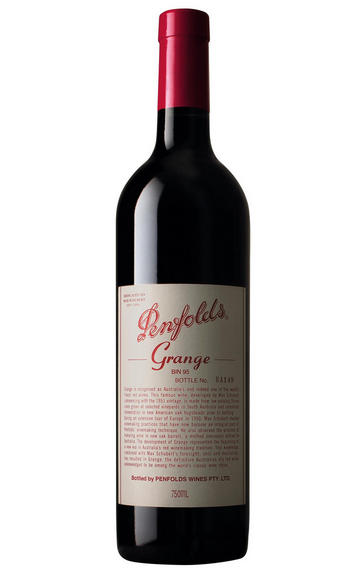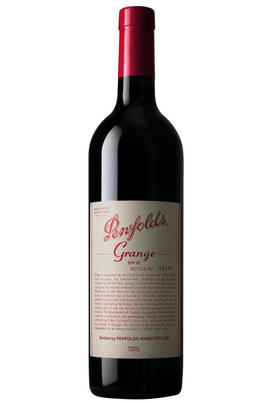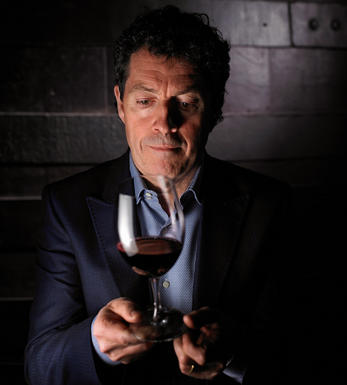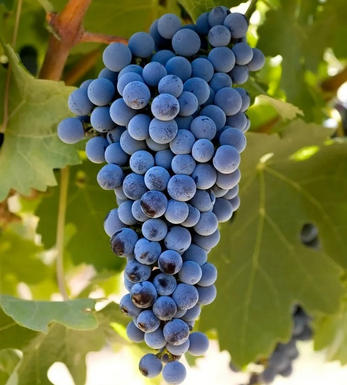
2003 Penfolds, Grange, Bin 95, Australia (Museum Stock)

Critics reviews
Inky purple. The seductively perfumed nose offers cassis, blueberry, cherry-cola, violet and dried fig scents, with a suave undercurrent of smoky minerals. Deep, finely etched cherry and dark berry flavours are complicated by mocha and candied liquorice, becoming riper with air. Cured meat and black cardamom notes arrive with air, adding further interest. Full, fleshy and sweet on the impressively long finish, which is nicely braced by dusty tannins. This is more energetic than most wines from this vintage.
Josh Raynolds, Vinous.com (September 2008)
Tasted blind. Vibrant crimson. Mint and some TCA on the nose, but the palate is really rather gorgeous! I really like the texture of this wine, even if the flavour is a bit spoilt by presumably a tainted cork (less concentrated wines would be worse affected). Rich but restrained. Long. My score ignores the TCA. Salty and firm with great plush richness across the palate and some tannins, doubtless exaggerated by the TCA.
Drink 2015 - 2025
Jancis Robinson MW, JancisRobinson.com (September 2015)
Penfolds- iconic 2003 Grange is Shiraz blended with 3.5% Cabernet Sauvignon from Coonawarra. It was aged for 15 months in 100% new American oak. Opaque purple-coloured, it offers up aromas of cedar, cigar box, leather, Asian spices, and blueberry. On the palate it is layered but a bit short on depth and grip with only moderate length. It will evolve for 5-7 years and drink well from 2014 to 2030. This is a good but not great vintage of Grange making it vastly overpriced.
Drink 2014 - 2030
Jay S Miller, Wine Advocate (February 2009)
About this WINE

Penfolds
Penfolds enjoys an iconic status that few New World producers have achieved. Established in 1844 at the Magill Estate near Adelaide, it laid the foundation for fine wine production in Australia.
The winemaking team is led by the masterful Peter Gago; it has the herculean task of blending the best wines from a multitude of different plots, vineyards and regions to create a consistent and outstanding range of wines. Its flagship wine, Grange, is firmly established as one of the finest red wines in the world.
Under Gago’s stewardship, the Penfolds range has evolved over time. Winemaking has moved away from New World heat and the sort of larger-than-life style that can mask individuality; the contemporary wines instead favour fine balance and typicity for the region or grape.

Barossa Valley
Barossa Valley is the South Australia's wine industry's birthplace. Currently into its fifth generation, it dates back to 1839 when George Fife Angas’ South Australian Company purchased 28,000 acres at a £1 per acre and sold them onto landed gentry, mostly German Lutherans. The first vines were planted in 1843 in Bethany, and by the 1870s – with Europe ravaged by war and Phylloxera - Gladstone’s British government complemented its colonies with preferential duties.
Fortified wines, strong enough to survive the 20,000km journey, flooded the British market. Churchill followed, between the Wars, re-affirming Australia’s position as a leading supplier of ‘Empire wines’. After the Second World War, mass European immigration saw a move to lighter wines, as confirmed by Grange Hermitage’s creation during the 1950s. Stainless-steel vats and refrigeration improved the quality of the dry table wines on offer, with table wine consumption exceeding fortified for the first time in 1970.
Averaging 200 to 400 metres’ altitude, the region covers 6,500 hectares of mainly terra rossa loam over limestone, as well as some warmer, sandier sites – the Cambrian limestone being far more visible along the eastern boundary (the Barossa Ranges) with Eden Valley. Following a diagonal shape, Lyndoch at the southern end nearest Gulf St Vincent is the region’s coolest spot, benefiting from sea fogs, while Nuriootpa (further north) is warmer; hot northerlies can be offset by sea breezes. The region is also home to the country’s largest concentration of 100-year-old-vine Shiraz, Grenache and Mourvedre.
Barossa Valley Shiraz is one of the country’s most identifiable and famous red wine styles, produced to a high quality by the likes of Rockford, Elderton, Torbreck and Dean Hewitson. Grenache and Mourvèdre are two of the region’s hidden gems, often blended with Shiraz, yet occasionally released as single vineyard styles such as Hewitson’s ‘Old Garden’, whose vines date back to 1853. Cabernet Sauvignon is a less highly-regarded cultivar.
Wines are traditionally vinified in open concrete fermenters before being cleaned up and finished in American and French oak barrels or ‘puncheons’ of approximately 600 litres. Barossa Shiraz should be rich, spicy and suave, with hints of leather and pepper.

Shiraz & Cabernet Sauvignon
Shiraz/Cabernet (or Cabernet/Shiraz, depending on which is the dominant variety) can be described as Australia's archetypal red wine blend. The blend can trace its roots back to 1865, when the famous Dr Guyot recommended it for the sunbaked vineyards of Provence. It became popular in the early 1960s and 1970s and came about largely due to the high demand for red wines and that fact there there was not enough Cabernet Sauvignon to meet this. At this time Shiraz was widely regarded as inferior to Cabernet Sauvignon and was still being grubbed up in Australian vineyards up until the mid 1980s.
The fleshiness and richness of Australian Shiraz acts as perfect foil for the more tannic and angular Cabernet Sauvignon and the blend is often matured in American oak, which adds notes of vanilla and spice. The proportions in the blend vary from 50/50 to 80/20 in some cases. It is seen across the whole quality spectrum in Australia and the blend is now been used in Languedoc Roussillon in France as well as in South Africa and California.


Buying options
Add to wishlist
Description
Tasted blind. Vibrant crimson. Mint and some TCA on the nose, but the palate is really rather gorgeous! I really like the texture of this wine, even if the flavour is a bit spoilt by presumably a tainted cork (less concentrated wines would be worse affected). Rich but restrained. Long. My score ignores the TCA. Salty and firm with great plush richness across the palate and some tannins, doubtless exaggerated by the TCA.
Drink 2015 - 2025
Jancis Robinson MW, JancisRobinson.com (September 2015)
wine at a glance
Delivery and quality guarantee